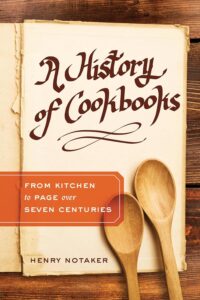A History of Cookbooks: From Kitchen to Page over Seven Centuries – Henry Notaker
 A History of Cookbooks: From Kitchen to Page over Seven Centuries. By Henry Notaker. (Oakland: University of California Press, 2017. pp. 384. Cloth, $39.95.)
A History of Cookbooks: From Kitchen to Page over Seven Centuries. By Henry Notaker. (Oakland: University of California Press, 2017. pp. 384. Cloth, $39.95.)
As mentioned in a previous post, I picked up this book expecting it to be a cultural history. What I got was a literary history of cookbooks, which wasn’t bad in and of itself. I learned a lot about how cookbooks have or haven’t changed over the last centuries, and reading about cookbooks from the fourteenth to sixteenth centuries was fascinating, but I was disappointed there wasn’t more about the nineteenth and twentieth centuries. For example, Notaker discusses as how cookbooks became more gendered toward the female as history progressed, however, he does not discuss the history of cookbooks in the 1950s and 1960s, in which cookbooks aimed primarily at white middle-class women constructed one facet of the idea of home. As I said, he does discuss gendered cookbooks and how they prescribed certain behaviors for women not only as cooks but also has heads of the domestic sphere in the household. I do think, however, it would have been fascinating to see his take on the cookbook literature of mid-century America, or even Europe, as I have no idea if cookbooks aimed at homemakers in America crossed the Atlantic or vice versa.
I found Notaker’s brief coverage of wartime cookbooks to be informative. It never occurred to me before that cookbooks might have been a way to generate nationalism (even if recipes in them came from somewhere else), especially during wartime. “Whether it was the intention of authors or not,” Notaker writes, “the books inevitably became tools for official propaganda” (261). I knew about freedom fries, but I did not know there was a long history of cookbooks and food culture being used during wartime to create a feeling of national belonging.
As I said, this is a literary study. It focuses most on not only what cookbooks contained, but how they were expressed and the needs they changed to meet or influence the world around them. His authors are mostly anonymous, which may reflect a paucity of sources in terms of recording authors’ names. But Notaker does a good job of tracing change over time. I recommend this read for people interested in investigating the form and content of cookbooks over time. I am not sure how I would use this book in a course but it would be suitable for an audience of undergraduates, who might groan at the length.
Update`12/29/2023: It occurred to me that I left out what drew me to vintage cookbooks in the first place: the images of food. As related, the images of the food (or other related, or unrelated subjects) are just as important as the recipes or other content. Images receive very little attention in A History of Cookbooks, which strikes me as a gross oversight considering images are such an important part of cookbooks’ narratives. Images are a text too, and it seems to me that Notaker could have spent an entire chapter tracing the development of images in cookbooks. It would have been interesting to hear his thoughts on these images and to trace their kind and mutations over time.
